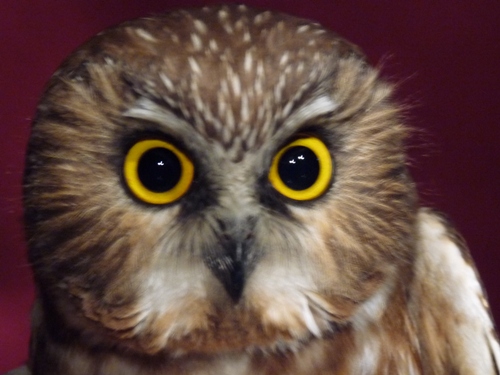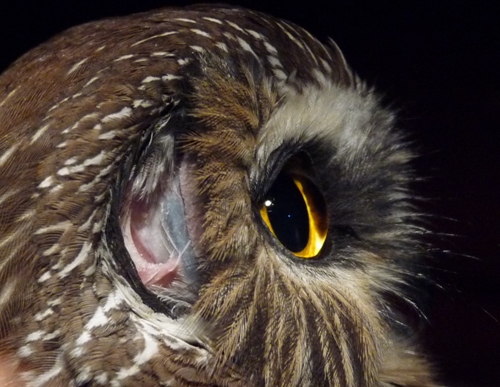|
McGILL BIRD OBSERVATORY |
|||||||||||||||||||||||||||||||||||||||||||||||||||||||||||||||
McGill Bird Observatory began experimenting with Northern Saw-whet Owl monitoring in the fall of 2004, which resulted in 17 saw-whets banded, plus an Eastern Screech-owl as an unexpected bonus. Similar totals were banded in 2005 (17) and 2007 (15), with 2006 and 2008 skipped due to a shortage of experienced owl banders. In 2009, the program was relaunched at a different location within MBO and effort was expanded, resulting in a dramatic improvement in results - 76 saw-whets and 2 screech owls banded. Based on this success, MBO applied for funding to support full coverage of the 2010 fall migration period. Thanks to a research grant from Bird Protection Quebec, the 2010 season extended from September 25 to November 13, during which nearly as many owls were banded as in the four previous seasons combined. Details are below.
Banders-in-charge: Simon Duval, Marcel Gahbauer, Kristen Keyes
This year we used the same basic net setup as in 2009, focused around the spruce-fir grove east of Stoneycroft Pond. We switched to 60-mm mesh nets (more ideally suited to catching saw-whets) for the five primary net lanes, but continued to also use two adjacent 30-mm mesh nets that are part of the passerine migration monitoring array (E1 and E2). Each night the bander-in-charge (one of Kristen, Simon, or Marcel), bander-in-training (Bob), and additional volunteers opened up the nets at dusk for a minimum of four hours, during which the audiolure in the midst of the nets was continuously broadcasting a male saw-whet call. We began owling this year on September 25, but it was still mild and we caught nothing that night or the next. After being rained out the next two evenings, we tried again on September 29 and had our first owl of the season. We were stunned when just three nights later on October 2, we banded 15 saw-whets - our second highest total ever for a single night, and much earlier in the season than peak flights in previous years. Another 7 the next night was promising, but then we banded only 10 more over the following week, so it seems like we experienced an early wave of migrants, as reported at some other banding stations. Our overall peak for the season came on October 11 when we banded 18 saw-whets in one night, which was a new record for MBO. Combined with another 10 on October 12, we had nearly one-quarter of the season's owls on just these two nights, closely corresponding to our typical peak period of October 12-14. For the remainder of the season we had two more very good nights (11 on October 18, and 12 on October 23), but on the whole numbers tapered off, though we still banded 22 saw-whets in November, more than twice as many as in any previous year, confirming that the migration does continue later than we had originally thought. Our final night of owling this year was November 13, with the lack of saw-whets that evening confirming our decision to wrap up for the year - though the season's second Eastern Screech-owl was a nice reward for being out that night. Overall we ended up with 35 nights of owling, having lost 12 nights during the main part of the season (Sep 25 - Nov 5) to rain, snow, or high winds, and skipping another 3 nights in November due to scheduling conflicts. Although the 124 owls banded was a new record by a wide margin, the capture rate was actually a bit lower than in 2009 due to the increased effort (not only 25% more nights, but also longer hours on average). There was actually a 125th bird banded during the owl banding program - a Slate-colored Junco that hit one of the nets at 11:30 pm on November 1, reminding us to always be prepared for the unexpected! Of the saw-whets we banded this fall, 86 (70%) were hatch-year birds, while another 25 (20%) were second-year, and the other 11 (10%) were older, with at least one being a minimum of four years old. This is slightly different from last year, when we had 76% hatch-year and just 9% second-year. As is typical with saw-whet banding, there was a distinct female bias to the results, with 85 (69%) females, just 12 (10%) males, and the remaining 25 (20%) of undetermined sex due to intermediate size and weight. Like last year, we caught two foreign-banded saw-whets over the course of the season. On October 3, we caught a second-year female that had been banded as a hatch-year bird on October 19 last year, roughly 60 km southwest of Boston. Then during our record night on October 11, we caught a hatch-year owl banded less than two weeks earlier at Hilliardton Marsh in northeastern Ontario, roughly 500 km northwest of MBO. Then on October 21, we got news that a saw-whet we banded on October 12 last year as a second-year female had been recaptured at a banding station in Little Gap, Pennsylvania (roughly 500 km south of MBO, and 120 km west of New York City). Also of note, on October 31 we recaptured a saw-whet we had banded on October 2; presumably it had stayed relatively nearby, but despite frequent attempts throughout the season to search likely roost locations in daylight, we have yet to observe a saw-whet anywhere in MBO during the day. As usual, being out at night allowed us to detect a number of species other than the saw-whets we were targeting. The most notable of these was again Long-eared Owl. At least two of them were present nightly for much of the season, detected primarily by their persistent vocalizations, sometimes beginning as early as dusk. Long-eared Owls have an amazingly wide repertoire of sounds, which depending on the season can include hoots, barks, cackles, and even loud claps made with their wings in flight. However, these particular owls favoured rough shrieks and a loud whistle that was remarkably similar to the call of a Black-bellied Plover (except that it was clearly coming from a tree perch!), which we eventually learned was a juvenile call. Wandering the census trail in the dark on a few nights eventually resulted in a few sightings of the Long-ears, though of course they were little more than moonlit silhouettes. Aside from them, we heard saw-whets and screeches away from the nets, as well as a Great Horned Owl on a couple of occasions. We also regularly heard White-throated Sparrows and Slate-colored Juncos giving chip calls well into the night, while other species we recorded at least once included Canada Goose, Mallard, American Woodcock, Wilson's Snipe, Mourning Dove, and Song Sparrow. For a second year, we were fortunate to have three banders-in-charge to share the schedule, and just as importantly, the dedicated support of Bob Barnhurst throughout the season as bander-in-training, effectively giving us a two-person banding team every night. We also had great volunteer involvement this year, with a full complement of three assistants on over 85% of nights, plus two nights with larger groups visiting from local birding clubs. Given the success we have had with the saw-whet program the past two years, not to mention the ever-growing volunteer interest, we are eager to continue with full coverage in fall 2011 - especially since population trends across much of the east suggest that next year could be the peak of the saw-whet's typically four-year cycle. To help ensure sufficient funding is in place for full coverage of the season, we have launched an adopt-an-owl program, where MBO will isue personalized 8.5" x 11" certificates including a photo of the adoptee's owl and details such as its age, sex, weight, and date banded, plus any news we receive if the owl is subsequently reported elsewhere. Click here for details on how to request an adoption. We look forward to sharing results again beginning in week 9 next fall.
|


